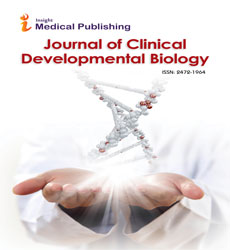Characteristics of Stem Cell Research
Rakshitha Kotha
Rakshitha Kotha*
Department of Biochemistry, Osmania University, Hyderabad, Telangana, India
- *Corresponding Author:
- Rakshitha Kotha
Department of Biochemistry
Osmania University, Hyderabad, Telangana, India
Tel: +32-466-90-05-61
E-mail: raksh32311@gmail.com
Received Date: October 20, 2021; Accepted Date: October 25, 2021; Published Date: October 30, 2021
Citation: Rakshitha K (2021) Characteristics of Stem Cell Research. J Clin Dev Biol. 6:01.
Editorial
Characteristics of Stem Cell Research
Stem cells have the ability to regenerate and repair all of the tissues in the human body, making them ideal candidates for future therapeutic applications in tissue regeneration and repair. Cells must exhibit two key traits in order to be classified as stem cells. To begin, stem cells must have the ability to self-renew indefinitely and produce children that are identical to the originator cell. This is also true of cancer cells, which divide uncontrollably in contrast to stem cell division, which is well regulated. As a result, it's critical to remember that stem cells must also be able to give rise to a specialised cell type that becomes a part of the healthy animal.
The term "stem cell" refers to a variety of different cell types. Adult stem cells, more correctly termed "somatic" stem cells meaning "from the body," are found in the foetus, placenta, umbilical cord blood, and infants, but these terms are becoming inadequate as new research has discovered how to turn fully differentiated adult cells back into embryonic stem cells. As a result, pluripotent stem cells and multipotent stem cells will be divided into two categories in this review based on their biologic qualities. Pluripotent stem cells get their name from their ability to differentiate into any form of cell in the body. Pluripotent stem cells are only present in the embryo for a short time before differentiating into the more specialised multipotent stem cells that eventually give rise to the body's specialised tissues in natural development. There are numerous varieties of these more limited multipotent stem cells: some can only become cells of a specific germ line (endoderm, mesoderm, ectoderm), while others can only become cells of a specific tissue. In other words, pluripotent cells can differentiate into multipotent stem cells, which then divide into even more restricted specialised cells, allowing them to finally become any cell in the body.
Cancer stem cells are a type of cancer cell that responds to cancer drug resistance and tumour recurrence. This notion has a significant impact on cancer treatment strategy and anti-cancer medication development. For many years, the new understanding of stem cells has been used to successfully treat leukaemia (induced differentiation) and bone/blood cancer (bone marrow transplants).
Stem Cell Origins
Totipotent
Totipotent stem cells have the ability to divide and differentiate into any type of cell in the body. Totipotency allows cells to create both embryonic and extra-embryonic structures and has the maximum differentiation potential. A zygote, which is generated when a sperm fertilises an egg, is an example of a totipotent cell. These cells can develop into any of the three germ layers or a placenta later on. The blastocyst's inner cell mass becomes pluripotent after around 4 days. Pluripotent cells come from this structure.
Pluripotent
The majority of pluripotent stem cells employed in research today come from embryos, hence the term "embryonic stem cells." Only 10-15% of pluripotent cells exist in the "inner cell mass" of pre-implantation embryos that are a few days old. These pluripotent cells can be separated and cultivated atop a layer of "feeder" cells that offer unknown cues for several rounds of growth while maintaining pluripotency. In medicine, induced pluripotent stem cells (iPS) have a unique relevance since they can be produced to derive from a variety of adult tissues or organs using protein factors. Their characteristics may resemble those of normal embryo stem cells. They give a source for stem cells that is free of ethnic tensions.
Multipotent
Multipotent stem cells could be a potential clinical approach. These cells can become all of the progenitor cells for a specific germ layer or they can be confined to one or two specialised cell types for a specific tissue. PSCs have a broader differentiation spectrum than multipotent stem cells, yet they can specialise in distinct cells of specific cell lineages. A haematopoietic stem cell, for example, can grow into a variety of blood cells. A haematopoietic stem cell becomes an oligopotent cell after differentiation. Its ability to differentiate is then limited to cells of the same lineage. However, certain multipotent cells have the ability to convert into unrelated cell types, implying that they should be called pluripotent cells.
Open Access Journals
- Aquaculture & Veterinary Science
- Chemistry & Chemical Sciences
- Clinical Sciences
- Engineering
- General Science
- Genetics & Molecular Biology
- Health Care & Nursing
- Immunology & Microbiology
- Materials Science
- Mathematics & Physics
- Medical Sciences
- Neurology & Psychiatry
- Oncology & Cancer Science
- Pharmaceutical Sciences
